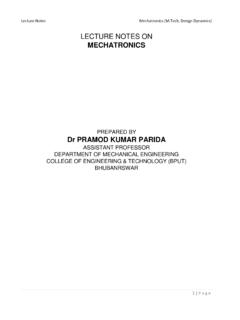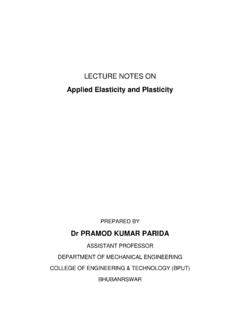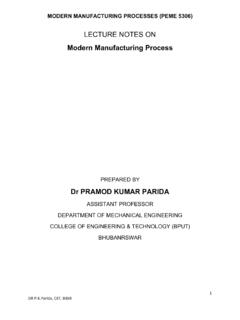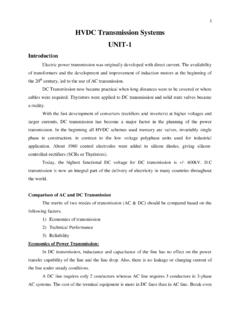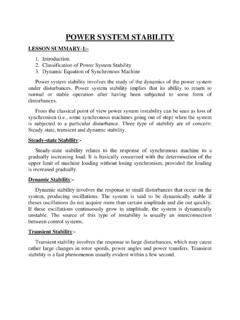Transcription of Power System Protection - College of Engineering and ...
1 Power System Protection 1 Power System Protection LECTURE NOTE BY Dr Power System Protection 2 Disclaimer This document does not claim any originality and cannot be used as a substitute for prescribed textbooks. The information presented here is merely a collection by the committee faculty members for their respective teaching assignments as an additional tool for the teaching-learning process. Various sources as mentioned at the reference of the document as well as freely available material from internet were consulted for preparing this document. The ownership of the information lies with the respective authors or institutions. Further, this document is not intended to be used for commercial purpose and the committee faculty members are not accountable for any issues, legal or otherwise, arising out of use of this document.
2 The committee faculty members make no representations or warranties with respect to the accuracy or completeness of the contents of this document and specifically disclaim any implied warranties of merchantability or fitness for a particular purpose. Power System Protection 3 CHAPTER 1 Basic ideas of Relay Protection A good electric Power System should ensure the availability of electrical Power without any interruption to every load connected to it. Generally Power is transmitted through high voltage transmission line and lines are exposed, there may be chances of their breakdown due to storms, falling of external objects, and damage to the insulators etc. These can result not only mechanical damage but also in an electrical fault. Protective relays and relaying systems detect abnormal conditions like faults in electrical circuits and automatically operate the switchgear to isolate faulty equipment from the System as quick as possible.
3 This limits the damage at the fault location and prevents the effects of the fault spreading into the System . The switch gear must be capable of interrupting both normal currents as well as fault current. The protective relay on the other hand must be able to recognize an abnormal condition in the Power System and take suitable steps so that there will be least possible disturbance to normal operation. Relay does not prevent the appearance of faults. It can take action only after the fault has occurred. However, there are some devices which can anticipate and prevent major faults. For example, Buchholz relay is capable of detecting the gas accumulation produced by an incipient fault in a transformer. Nature and causes of faults The nature of fault simply implies any abnormal condition which causes a reduction in the basic insulation strength between phase conductors, between phase conductor and earth or any earth screen surrounding the conductors.
4 The reduction of the insulation is not considered as a fault until it produces some effect on the System until it results either in an excess current or in the reduction of the impedance between the conductors, between the conductor and earth to a value below the lowest load impedance normal to the circuit. Power systems mainly consist of generator, switch gear , transformer and distribution System . The probability of failure is more on the Power System due to their greater length and exposure to atmosphere. (a) Breakdown at normal voltage may occur on account of: i) The deterioration of insulation (ii) Damage due to unpredictable causes such as perching of birds, accidental short-circuiting by snakes, tree branches, etc. (b) Breakdown may occur because of abnormal voltages: This may happen because of (i) switching surges (ii) surges caused by lightning Power System Protection 4 The present practice is to provide a high insulation level of the order 3 to 5 times the normal voltage, but still: (i) The pollution on an insulator string caused by deposited soot or cement dust in industrial area.
5 (ii) Salt deposited wind borne see spray in coastal area. These will initially lower the insulation resistances and causes a small leakage current to be diverted, thus hastening the deterioration. Secondly, even if the insulation is enclosed, such as sheathed and armoured, the deterioration of the insulation occurs because of: (a) Ageing (b) Void formation in the insulation compound of underground cable due to unequal expansion and contractions caused by the rise and fall of temperature. Thirdly, insulation may be subjected to transient over voltages because of switching operation. The voltage which rises at a rapid rate may achieve a peak value which approaches three times phase to neutral voltages. Lightning produces very high voltage surges in the Power System in the order of million volts. These surges travel with the velocity of light in the Power circuit. The limiting factors are the surge impedance and the line resistance.
6 Consequences of Faults Serious results of the uncleared fault, is fire which may not only destroy the equipment of its origin but also may spread in the System and cause total failure . Consequences; 1. A great reduction of the line voltages. 2. Damage caused to the element of the System by the electrical arc. 3. Damage to other parts due to overheating. 4. Disturbanceto the stability of the electrical System and this may even lead to a complete shutdown of the Power System . 5. Reduction in the voltage may fail the pressure coil of the relay. 6. Considerable reduction in the voltage on healthy feeder connected to the System having fault. This may cause either an abnormally high current being drawn by the motor or the operation of no volt coils of the motors. (Considerable loss of industrial production as the motors will have to be restarted). Power System Protection 5 Fault Statistics Equipments % of total faults O H line 50 Cables 10 Switchgear 15 Transformer 12 CTs & PTs 2 Control Equipment 3 Miscellaneous 8 L-L-L fault are called symmetrical 3- fault generally due to carelessness operating personnel.
7 Usually the three phase lines are tied up together a bare conductor in order to protect the lineman working on the line against inadvertent-charging of the line. After work is over, if the linesman forgets to remove the tie-up and CB is closed, a symmetrical fault occurs. Line to ground fault occurs most commonly in overhead line. A large no of these faults are transitory in nature and may vanish within a few cycles (if twig falls across a line and cross arm and burns itself out or just falls down). Essential Qualities of Protection Every protective System which isolates a faulty element must satisfy four basic requirements:1. Reliability 2. Selectivity 3. Fastness of operation 4. Discrimination Reliability Reliability is a qualitative term. It can be expressed as a probability of failure . Quality of personnel mistakes by personnel are most likely causes of failure . high contact pressure dust free enclosures Records show that the order of likelihood of failure is relays, breakers, wiring, current transformers, voltage transformers and battery.
8 When relays using transistors are considered, the failure rate goes up still further. Selectivity :The property by which only the faulty element of the System is isolated and the remaining healthy sections are left intact. Selectivity is absolute if the Protection responds only to faults within its own zone and relative if it is obtained by grading the setting of protections of several zones which may Power System Protection 6 respond to a given fault. The systems of Protection which in principle are absolutely selective are known as unit System . The systems which selectivity is relative are non unit System . Fastness of Operation Protective relays are required to be quick acting due to the following reasons: (a) Critical clearing time should not be exceeded. (b) Electrical apparatus may be damaged, if they are made to carry fault currents for a long time. (c) A persistent fault will lower the voltage resulting in crawling and overloading of industrial drives.
9 The figure below shows the typical values of Power , which can be transmitted as a function of time. On the other hand, relays should not be extremely fast; otherwise the relay will operate for transient conditions. Discrimination Protection must be sufficiently sensitive to operate reliably under minimum fault condition for a fault within its own zone while remaining stable under maximum load a relay should be able to distinguish between a fault and an overload. In the case of transformers, the inrush of magnetising current may be comparable to the full current, being 5 to 7 times the full load current. The relay should not operate for inrush current. In interconnected systems, there will be Power swing, which should also be ignored by the relay. The word discrimination is sometimes used to include selectivity. Primaries and Backup Protection The relay operates usually from current and voltage derived from current and potential transformers.
10 A station battery usually provides the circuit breaker trip current. Successful clearing depends on the condition of the battery, continuity of the wiring and trip coil and the proper mechanical and electrical operation of the circuit breaker, as well as the closing of the relay trip contact. If there is failure of these elements, so that the fault in a given zone is not cleared by the main or primary Protection scheme, some of the backup Protection is generally provided. The backup Protection is normally different from main Protection and preferably of non-unit type. Ex: overcurrent or distance Protection Selectivity is absolute if the Protection responds only to faults within its own zone and relative if it is obtained by grading the settings of Protection of several zones which may respond to a given fault. Systems of Protection which in principle are absolutely selective are known as unit System .


